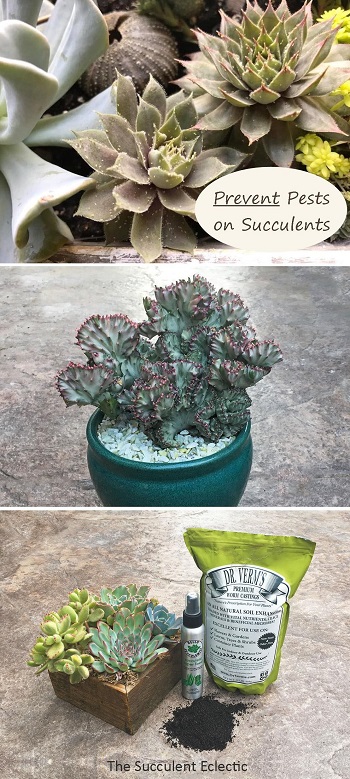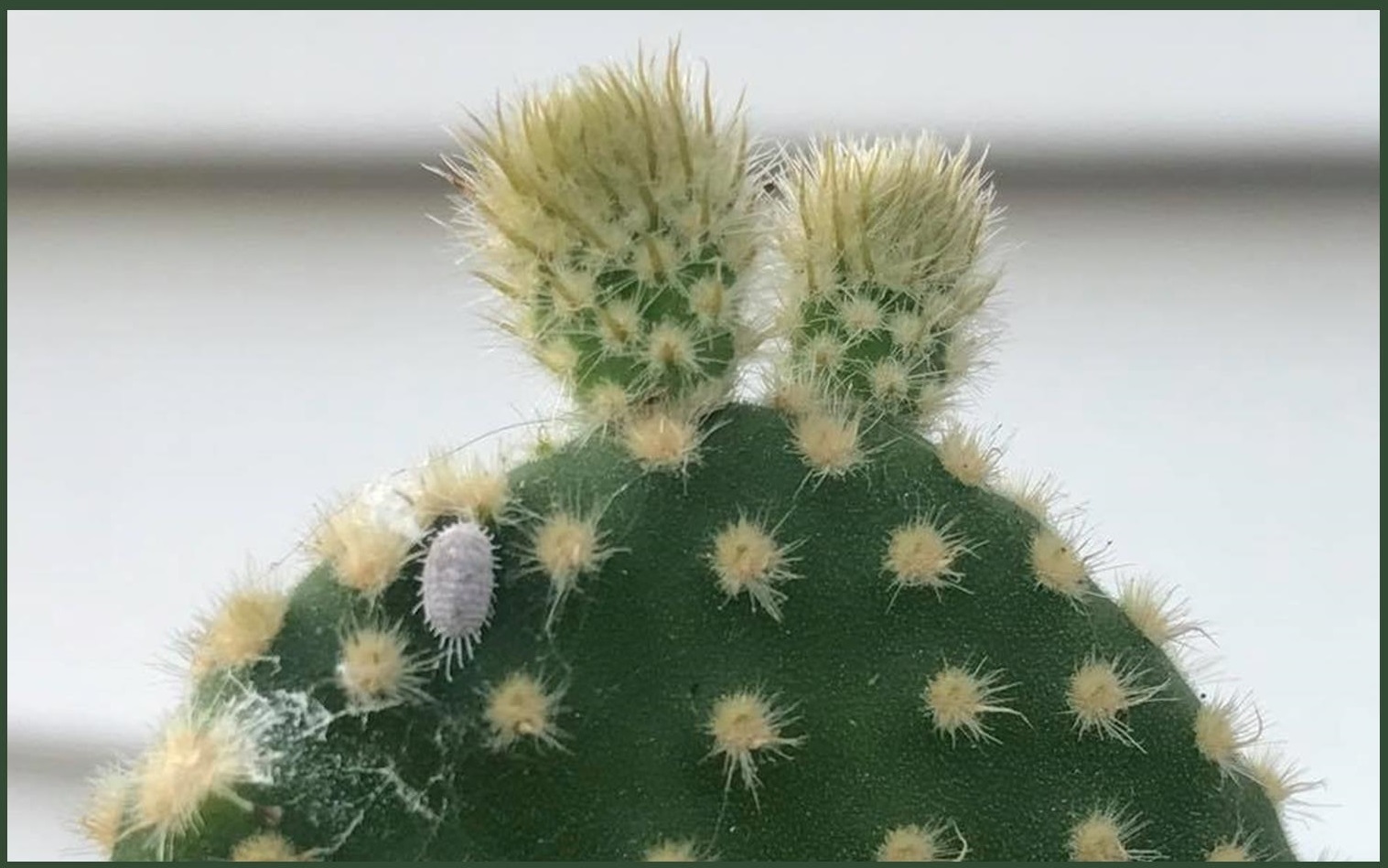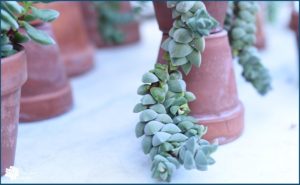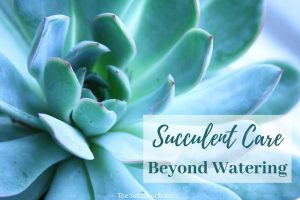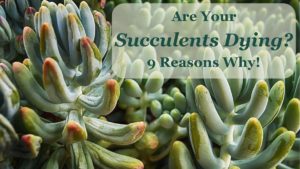I love talking about the many fun sides of succulents. But today, we need to talk about pests on succulents. I don’t mean the neighbors’ kids — I’m talking those nasty little sap-sucking insects feeding on the juices inside your succulents. In a short time, a few become many, and they can do real damage. If you love growing and collecting succulents, you will someday face mealybugs on succulents. Let’s see how to get rid of them. Even better, I will show you how to prevent them!
Treatment and Prevention of Pests on Succulents
In this Post We'll Cover:
{Please note, some links in this post may be affiliate links to sites that pay me a small commission if you click on the link and make a purchase. This commission is at absolutely no cost to you. I only recommend products and companies that I have worked with and truly love! ~Kat}
Recognizing Mealybugs on Succulents
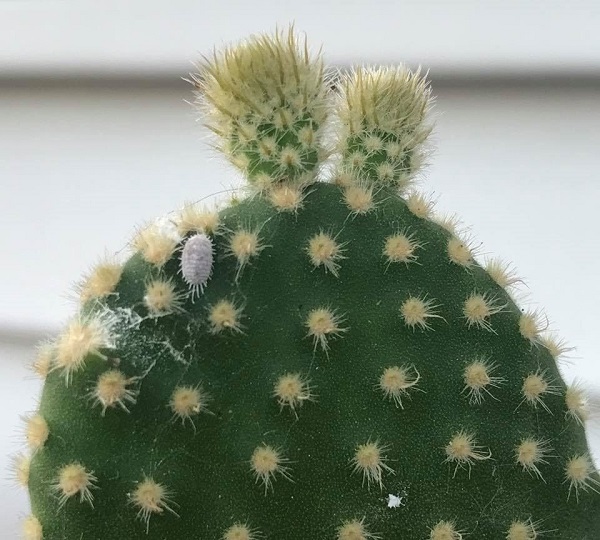
Full disclosure here — I am not that great at identifying individuals in the large group of pest insects that are a plague on succulents. Although I am certain God had great reasons for making so many, and making them each distinct, I tend to lump insects largely into the categories of Friend or Foe. With respect to succulents, the foe insects include mealybugs, whiteflies, aphids, scale, thrips and mites among others. Although they have their differences, each feeds by sucking on the sap of plants. You can see why they find thick, juicy succulent leave so attractive. In time, they drain the vitality of the succulent, making it more vulnerable to damage from stress and disease. As they feed, they lay eggs, hatching more hungry mouths to further damage your plants.
Typically, your first sign of mealybugs on succulents is a white, fluffy substance. Upon closer inspection, you may notice tiny little legs. They may cling to the underside of the leaves, or hide in the small crevices between the leaf and the stem. Some insects instead look like small black or brown bumps, or black specks, and may cling to the stems of your plants. Often, they lay their eggs just under the soil’s surface. The key is to remain vigilant. When you see the first signs of pests on succulents, take action! The cactus above had just a single mealybug when it was spotted and successfully treated, with no further infestation. While many insects produce a white residue, be sure to recognize the difference between insects and epicuticular wax or farina on your succulents. Thank you, Brittany Smith, for the use of this photo! Check out Brittany’s love of succulents on Instagram!
Aphids on Succulents? Isolate the Plant
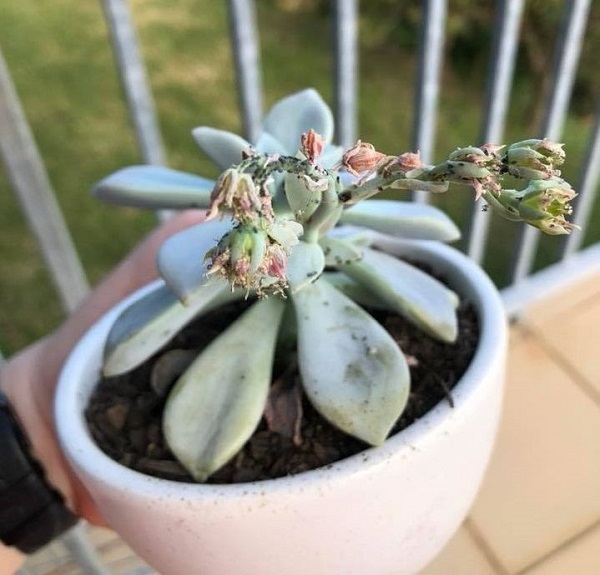
Some succulents are especially attractive to pests. Echeveria in bloom are magnets for aphids. Many collectors refuse to let them bloom for this very reason. The first step in controlling pests on succulents is to watch for them. Like mealybugs, aphids secrete a sweet substance known as honeydew which will attract ants. So if you see ants on your succulents, that is a good clue that other pests may be lurking there, too. As soon as you see the first signs of insects, isolate that succulent to prevent their spread to your other plants.
There are a few treatment options I recommend at this stage. With a single insect, like the one mealybug at the top, or a few like these aphids, soak a Q-tip in isopropyl alcohol (rubbing alcohol) and dab it directly onto each insect. The alcohol dissolves the exoskeletons of the insects and their eggs. 70% is the most effective alcohol to use, as the stronger 91% evaporates too quickly to kill all the insects and eggs. Thanks to the tough skin succulents develop to prevent water loss, the alcohol is not damaging to your succulents, but take care with other plants. And always, ALWAYS treat succulents out of the direct sun. Plan to leave your succulents sprayed with alcohol protected from direct sun for 24 hours to avoid discoloring. This is a highly effective method to kill the adult stage of aphids, scale, mites, whiteflies or mealybugs on succulents. Plan to repeat the process every 2-3 days for a week to ensure you kill the juvenile stage insects as they mature, too. My thanks to Caitlin Rose for the use of this photo!
Controlling Whiteflies on Succulents
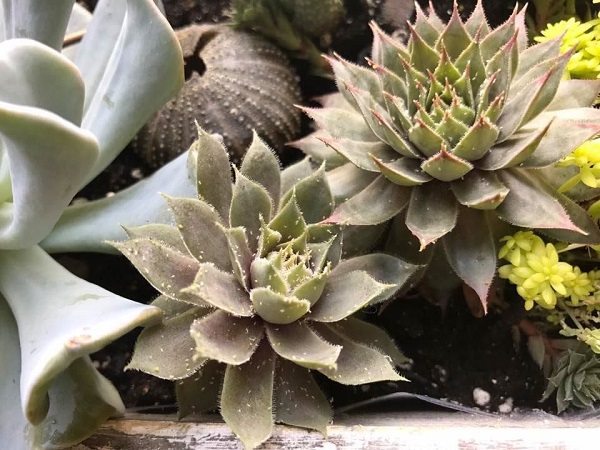
In a short time, a few insects become many, and they start to spread out. These whiteflies were throughout the sempervivum —as evidenced by the casings — and would soon spread to the surrounding succulents. When it is not practical to dab each insect as an individual with your alcohol, pour it into a spray bottle and spray the insects. Again, this will not harm your succulents. Their skin is thick, evolved to keep their precious stores of moisture secure. Spray the soil, too, to be sure to kill any eggs. The alcohol rapidly evaporates, doing its duty and quickly disappearing. However, do not treat your plants during the heat of the day, when the sun is on them. Do so in the early morning, or in the evening after the sun has passed.
Another good way to treat an infestation of insects or mealybugs on succulents is with insecticidal soap. For store-bought, I recommend Safer Brand Insect Killing Soap. However, you can make your own, highly effective insecticidal soap spray. Use 1 cup water, 1 cup isopropyl alcohol and add 1/2 teaspoon dishwashing soap like Dawn. Use the soap for in your sink, not what you use in the dishwasher, and don’t use one that contains chlorine. Shake well and spray on your infested plants. The soap will smother juvenile insects that may survive the alcohol spray. Again, take care to use only in the early mornings or evenings, out of the direct sun. Thank you, Lindsy Hemmersbach for the use of this photo!
Ladybugs Treat Pests on Succulents
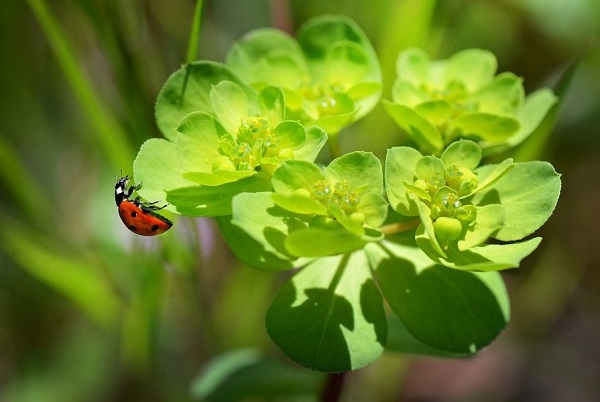
If you have a widespread issue with pests on succulents growing outdoors, try releasing ladybugs! These are insects on the Friends list, and their natural food source is a wide range of succulents pests. These little ladybugs are predators that will feast on soft-bodied insects like aphids, soft-bodied scale, mites and mealybugs on succulents and throughout your garden. You can purchase healthy ladybugs online or sometimes at your local nursery. While not practical for treating pests on your indoor plants, they will quickly clean up the pests in your garden. Don’t be surprised to see them disappear once your garden is pest-free — they are searching for more food.
Be sure to release your ladybugs in the early evening, so they don’t fly away before exploring your garden. Spray your garden with water before releasing the ladybugs to ensure they can find a good drink nearby. Ladybugs are an excellent way to control for pest insects in your garden. Take care not to use insecticides once you release them. Chemical controls will harm beneficial insects like ladybugs, too.
Top Dressing to Cut Down Pests on Succulents
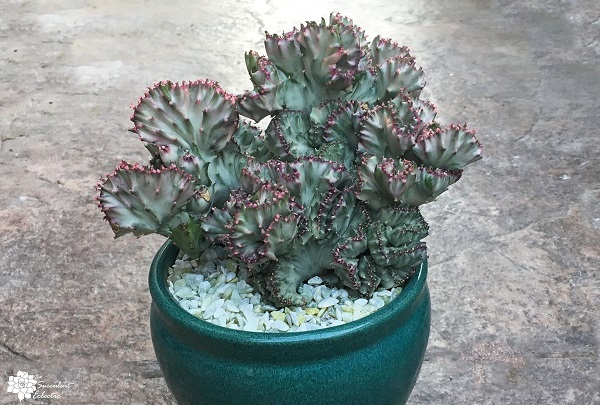
My final recommendation for combatting pests on succulents is to use an inorganic top dressing on the soil. While mealybugs and aphids lay eggs on the leaves, some pests lay their eggs in the soil of your plants. The obnoxious little gnats that lurk around indoor plants lay their eggs in the upper reaches of the damp, organic soil. When you apply a layer of inorganic top dressing, like decorative pebbles, perlite or sand, it prevents the insects from reaching the soil, and any hatchlings cannot reach the surface. The eggs cannot live on the inorganic matter. Even a bad infestation of gnats indoors will clear up in days simply by applying a half inch layer of inorganic top dressing on the soil. The gnat’s life cycle is so short, and reproduction is so fast, that this step alone will end the infestation indoors. You may be familiar with the many other benefits of using an inorganic top dressing like this. It keeps the plant clean, soil does not splash up onto the leaves. It prevents water from evaporating too quickly on hot days. And it really ties the look of your planting together, while masking the look of the bare soil.
Treating Pest and Mealybugs on Succulents
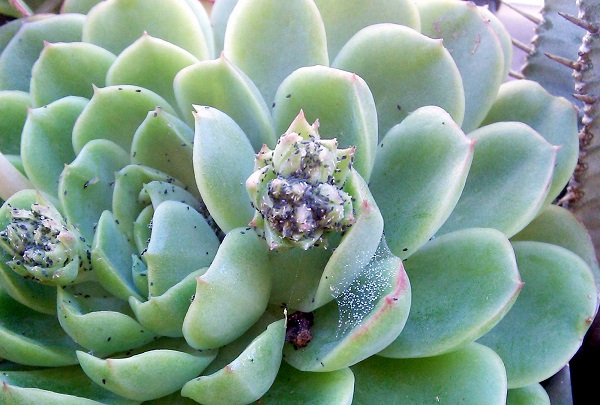
To recap, these are the steps for treating pests on succulents once you have a problem:
- Be watchful — The sooner you spot insects, the easier they are to deal with.
- Isolate the plant with pests — to keep the insects from spreading to the rest of your succulents.
- Dab with alcohol — Spot treat individual insects with isopropyl alcohol.
- Spray with alcohol or soap mix — Spray larger groups of insects with alcohol or soap mixture.
- Release Ladybugs — Clean your entire garden of pests by releasing ladybugs.
- Inorganic Top Dressing — Stop the life-cycle of insects that lay their eggs in soil.
Each of the above steps is a good way to treat insects that have already arrived. Even when there are no insects, I always look my plants over carefully, so I am alert to any changes in their condition. And an inorganic top dressing looks great in addition to providing excellent hygiene and preventing a few insects from becoming an infestation. Now let’s see how to prevent pests from troubling your succulents in the first place!
How to Prevent Pest and Mealybugs on Succulents

You may already know that worm castings are an excellent fertilizer for your succulents. But did you know they are also highly effective at killing and preventing insects? Worm castings are the manure from earthworms. Gardeners’ Black gold. There are six important benefits of worm castings for your succulents:
- Worm castings contain more than 60 micronutrients and trace minerals, feeding both your plants and the soil.
- Worm castings suppress pathogens, bacteria and harmful fungi in the soil, protecting plants from disease and rot.
- The use of worm castings improves soil drainage and boosts moisture retention.
- Worm castings fix heavy metals in the soil, preventing their uptake by your plants’ roots.
- Worm castings enable plant roots to handle soils with high or low pH values.
- Chitinase in worm castings kills and repels insects like whiteflies, aphids, mealybugs, mites, scale and thrips.
There is a lot to love here. Some of the benefits of worm castings are of particular interest to succulent lovers. Worm castings are an excellent fertilizer that will nourish your succulents without burning them. Your plants will be less prone to rot when you use worm castings. This does not mean it will now be safe to drown your plants! But any help on the rot issue is a boon for succulent growers. But the reason they are in this article is #6.
Worm castings are rich in chitinase, an enzyme that breaks down the exoskeletons of insects. As the roots take in the chitinase, it is dispersed throughout the cells of the plant. Insects sense the chitinase in the leaves, stems and roots and simply shun those plants. Sap-sucking pests will feed on any plant’s leaves. But just as allllll that moisture stored in the leaves makes an unguarded succulent particularly attractive, when filled with chitinase-laced moisture, succulents are extra scary. Prevention is everything! 🙂
How to Use Worm Castings
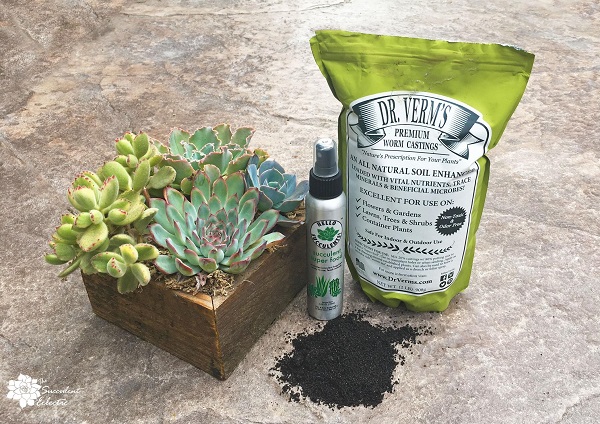
After reading the benefits of worm castings, it won’t surprise you that I do all I can to promote the health of earthworms in my soil. I even seek out worms to “plant” in my large containers. But that is not always practical, and it seems odd to put worms into small pots or with indoor succulents. Fortunately, there are easier ways to reap the benefits of worm castings for all your succulents!
Dr. Verm’s Premium Worm Castings is an excellent brand that raises and feeds their earthworms organically. I mix the dried worm castings in with my succulent soil. For a 4-inch pot, I mix in a couple tablespoons of worm castings and then plant my succulent. I use 3 tablespoons in a 6-inch pot and so on. In a gallon size pot, I use about half a cup. The measurements don’t need to be precise. Another excellent worm castings product is Hello Succulents natural worm tea food spray. It is a worm castings foliar spray that both feeds your plants and kills and repels insects. Simply spray a few pumps directly onto your plants’ leaves for a quick feed, and to kill any pests.
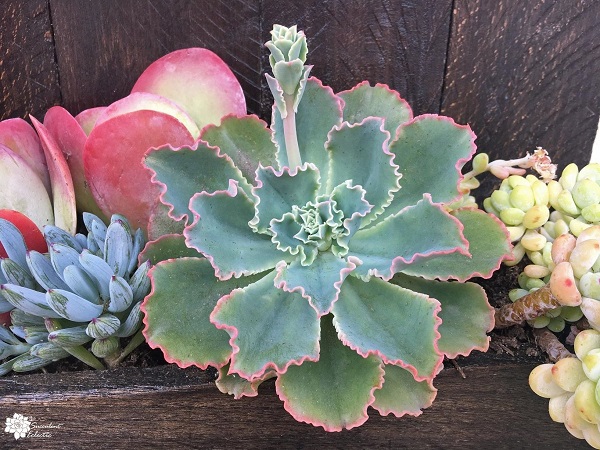
An infestation of insects can quickly turn your beloved succulents into a mess! Now you know the safe and effective methods I use to combat mealybugs on succulents, as well as a whole range of other pests. Even better — now you know how to prevent pests from becoming a problem in the first place. If you have any questions, please leave a comment. I will be happy to help! Enjoy your succulents pest-free!

P.S. Subscribe to The Succulent Eclectic and get my FREE course,7 Steps to Succulent Success,! Thanks!
